I love denim. I love it new and deeply saturated, I love it softly threadbare. I love the gradations of blue. Perhaps as a child of the 70s I just have jeans in my blood.
A recent Sunday found me and my quilts at Greenflea market on the Upper West Side in Manhattan, where an amiable man named Donald stopped to look at the quilts on the table and the fence.
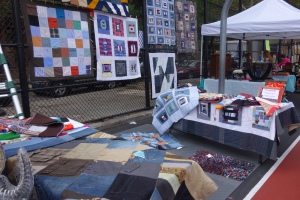
The patchwork on the table in the foreground is composed of jeans, khaki’s, canvas shorts, and upholstery samples
“If I gave you a bunch of jeans could you make me a quilt like that?” he asked. This is music to Patwig’s ears. I truly enjoy giving new form to clothes that would otherwise be discarded. And I like the surprises and challenge in coaxing something from a given pile of cast-offs. A few emails later I had these on my worktable.
Seven pairs of jeans and cut-offs and 14 legs, most blue and black, with one pair of corduroys and one pair of white denim in the mix. Donald wanted something that looked like the finished quilt he saw at Greenflea, but with a uniform border, for which he provided a yard-or-so of soft blue fabric.
One of the tricky bits about working with clothes, because of their shape and the need to cut unusable parts away, is that it’s not always clear how much is needed.
A quick arrangement of these cut legs helped me eyeball that there would be enough material to achieve the desired size. So I paired up pockets from different pairs of jeans.
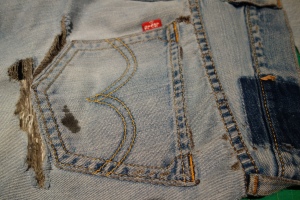
This piece looks like it might have an ink stain in the rear right pocket. Remember when we used to carry pens in our back pockets?
After much arranging and contemplating, I sewed until there were several rows, a beginning for the center of a queen bed. I thought this a good time to check with Donald to see if I was barking up the right tree, so I emailed him a picture of what I had so far.
He said it looked OK, but a bit boring, given the orderly grid. He also wanted more emphasis on the blues and less on the orange and white, which made up the majority of the piece so far.
Dear Reader, I wanted to do better than OK and a bit boring, so with his blessing I cut it up again. Then the project really opened up – it would be orderly no more …
With a lot more movement in the mix, my focus turned to getting the size right. The goal was 75 x 80, and the fabric Donald provided would yield a 6 inch border. So I had to close the gap between the center above and the planned outer border. Scrap time!
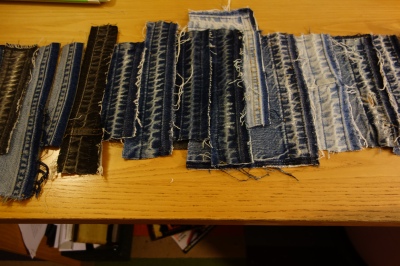
Frayed cuffs start openings in the bottom seams. Fully opening the hem triples the width of workable material and reveals a sort of tie-dye pattern
Strip borders are quick to compose and sew and, most dear to me, reduce waste. Less goes in the garbage can

A row at a time is sewn together, pinned to the center, then the whole piece is folded up, ready for Modest Machine
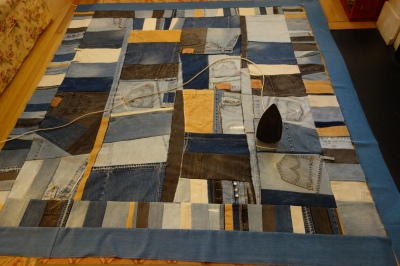
Once all 4 strip rows were done it was time to add the blue border. I think it frames the active center well
This part of quilt making is physical. Down on the floor, crawling from side to side while straightening, smoothing, pinning, and folding, then up and down the hall to feed carefully through the machine, sticking myself with pins multiple times along the way, then back to the floor, unfolding and doing it all again. Knees, back, ankles, wrists — all recruits to the effort. No wonder whole groups of women made larger quilts before labor saving devices were available.
Only once the outer border is done is it time to turn the quiltop design into what we know as a quilt. That starts with batting
The batting is placed on the floor and smoothed out
The quiltop is placed on the batting, right side up, smoothed out, then a single layer of backing is added. Sheets work well for this job.

Who knows what calculus goes into such decisions, but luckily for me, this baby blue in very good condition was retired from its household bedmaking rotation, donated to me, and perfect for this quilt
As well as being physical, the end stage of the process features craft and precision. It’s not especially fun. I’m always concerned that I’ll seriously mess something up and all will be lost.
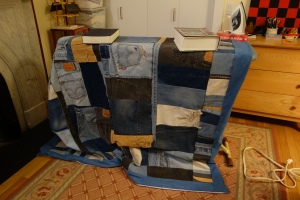
Once turned inside out, pressing outer borders is necessary to establish the edges. I do the first part on my ironing board then, you guessed it, back to the floor
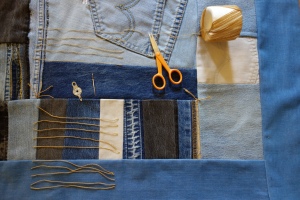
Simple ties will restrict shifting from the weight of the denim. This old spool of needlepoint thread — I think it was my mother’s or grandmother’s — matches the corduroy perfectly
As I go through my photos while writing this post, I realize I don’t have one overall picture of the finished quilt. What I do have are these detail shots, which is what I liked most working on this, the juxtapositions of various bits of old jeans.
You made it to the end! Hope you enjoyed this scroll through my quilt making process. Please feel free to share/link/forward Patwig’s Blog with anyone you think may enjoy it.
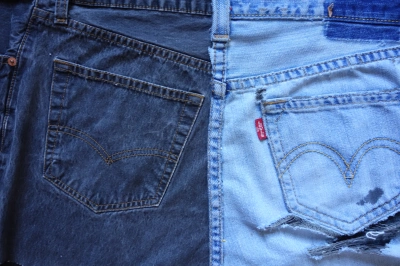

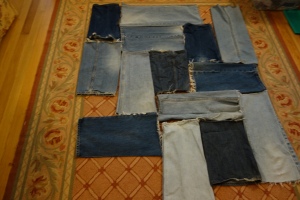
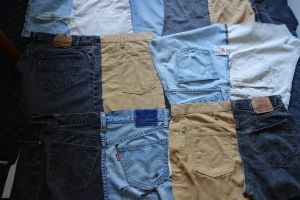

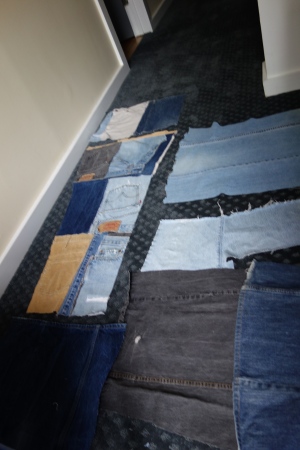
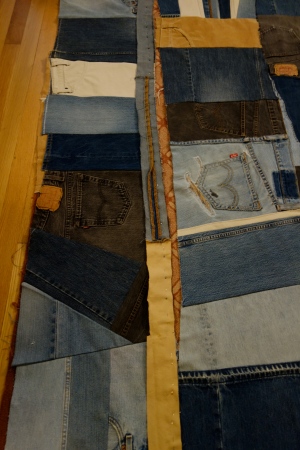
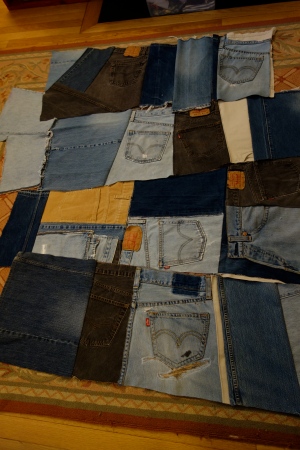
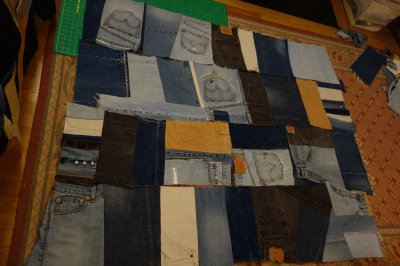
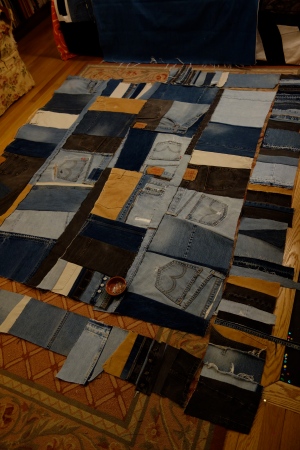




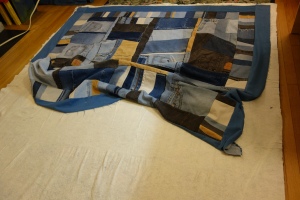

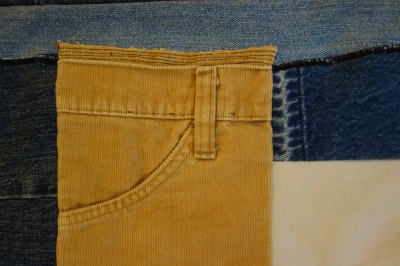
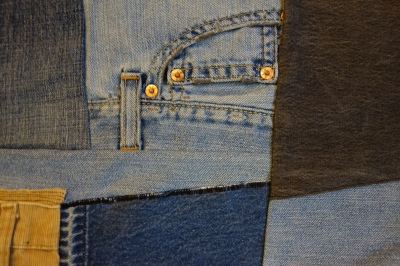

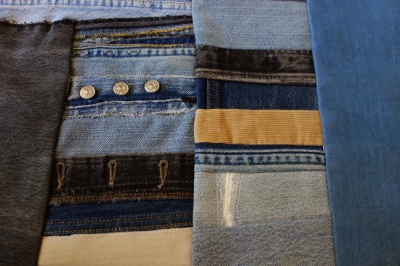
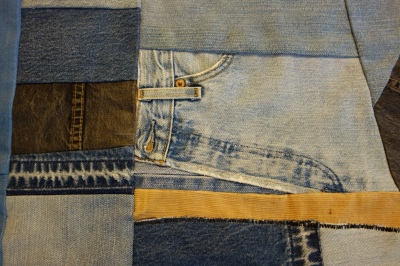
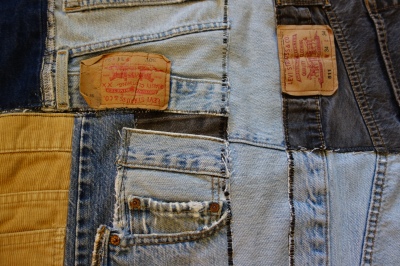

You’ve inspired me! I have a drawer full of too small, too worn, too dated and too torn jeans to play with, and the husband has a similar pile of blue drill work pants and safety orange work shirts. I feel yet another quilt coming on…
[…] This is certainly quite different from the things I do. But to our cats it’s all one (or none), I suppose. […]
What kind of machine are you using to sew your denim? Your work is so much fun! I love the use of preloved fibers.